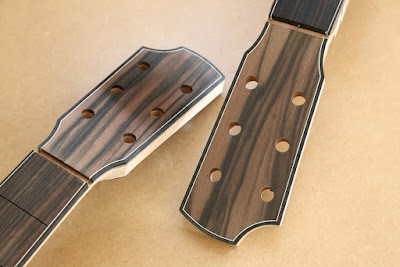As this is my first attempt at constructing an Irish bouzouki, the adventure has been a prolonged one - even more so than is usual.
Before I began the instrument, I thought long and hard about the preliminary design. It seems there are few established standards where even the most fundamental elements of the Irish bouzouki are concerned, to the extent that there's even debate online as to what constitutes a bouzouki in the first place. Throw the terms "octave mandolin", "mandocello" and "cittern" into the mix with "Irish bouzouki", and you'll find there's plenty of scope for healthy debate and disagreement!
After I'd drawn and redrawn the body outline any number of times, settled on a headstock shape that seemed to be in keeping with my guitar headstocks, decided on the number of frets to the body and the scale length, construction of a half-body template, then a full-body template, were necessary first steps even before I could consider fabricating the all-important outer body mold.
Given its narrow width, I was a little dubious about the strength of the first neck I made, and the second version, pictured hereabouts, incorporates two carbon fibre bars extending up into the headstock to provide additional strength and stability. In conjunction with the carbon fibre, a double-action truss rod has been installed in the usual manner.
After I'd fabricated the first ebony bridge and marked the position of the bridge pin holes, I was uneasy about their proximity to the rear edge of the bridge. That bridge was discarded, and I redrew the bridge outline and started again, taking into account what I'd learned from the first attempt.

The instrument body was sprayed and buffed out, using yet another waterbased product that promised so much but fell short of the mark in my estimation. Despite having invested a lot of time and effort, I judged it to be unsuitable, due mainly to its softness and the likely difficulty of future touch-ups. The finish was sanded off, a new finish material chosen, and it was back to the spray gun to begin the entire finishing process all over again.
Even now, with the instrument very nearly completed, I have plans to revisit the body outline I'll use on future instruments. I guess this is a natural process with any "prototype", so I'll think of this bouzouki as a first iteration and the basis for further experimentation and refinement in the months and years ahead.
Fortunately, I enjoy problem solving and learning new skills; this instrument has certainly provided many opportunities in that regard. I'll post photos of the completed bouzouki in the next week or two.
Cheers
Pete






















